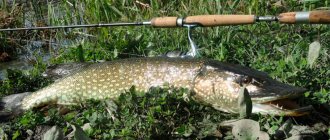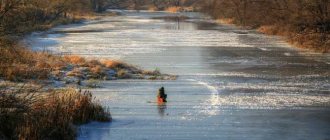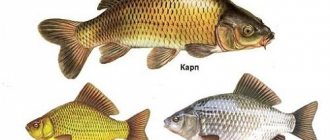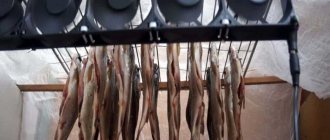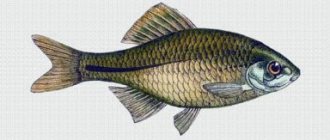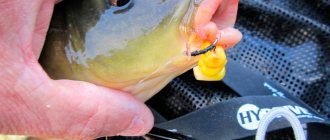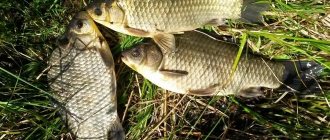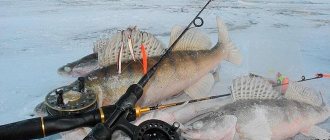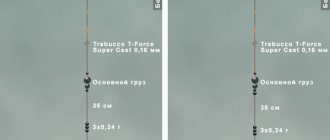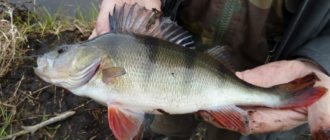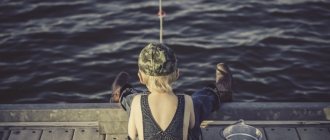The location of any predatory fish depends not only on the water temperature and time of year, but also on the availability of food supply. Any predator arranges ambushes and lives where its prey is, and it always accompanies it. In most cases, it is very difficult to determine the signs of a predator, since it leads a hidden lifestyle, but it is always easy to determine the presence of peaceful fish. This means that the fisherman should look for where schools of peaceful fish are moving, in what layers of water they are located, and where they feed; there will also be fish such as pike, pike perch, perch and other predators.
This will allow the angler to choose the right places on the pond, as well as support the necessary baits and fishing depth.
At any time of the year, the presence in a reservoir of such predators as pike, perch, pike perch and others can be determined by the presence of carp fish in the reservoir.
Therefore, to find a predator in a pond, pay attention to the following signs:
- the presence of schools of peaceful fish;
- find out the depth and temperature of water at different depths;
- determine whether there is vegetation and shelter in these places;
- study the migration routes of fish and the location of wintering pits.
Below I will give the main habits of peaceful fish depending on the time of year. Knowing them, you can optimally choose the fishing depth, select the right bait and tackle for catching a predator.
Spring
At the beginning of spring, the ice begins to melt, strong sunlight heats the surface of the water, which becomes enriched with oxygen and warms up. Peaceful fish begin to rise to the surface and look for shallower areas, as well as places for spawning.
By mid-spring, all the water already has the same temperature due to cyclical currents that bring oxygen to the bottom. Thanks to this, peaceful fish will be found in all layers of water in the reservoir.
At the end of spring, peaceful fish begin to look for warm places to spawn, so they all gather in shallow water.
Choosing a fishing spot
Finding yourself on an unfamiliar body of water, you have to look for a promising place for fishing, and this is not at all easy. Although it is not easy for novice fishermen, experienced fishermen will be able to quickly identify promising places by the nature of the movement of water in the reservoir. If this is a pond and the movement of water is limited by gusts of wind, then it is somewhat more complicated. In this case, completely different criteria for determining where fish are concentrated come into force.
Summer
At the beginning of summer, the water is already well saturated with oxygen, rapid growth of plants begins and all the fish disperse throughout the reservoir to different places. At this time, the predator can be found anywhere, as it also scatters throughout the entire reservoir.
In mid-summer, although the water on the surface is well saturated with oxygen, it is too warm for a comfortable habitat for peaceful fish. At the bottom, on the contrary, there is very little oxygen and the fish are not comfortable there. Therefore, it will look for places where there is oxygen and the temperature does not change much during the day, these are various places where cold springs flow, dams, well-shaded areas.
We recommend: What do bubbles in the water mean, and should you look for them when looking for fish and fishing spots?
During the daytime, it practically does not move around the reservoir, but by night it begins to move around the reservoir in search of food. Look for the predator in shaded areas with an influx of fresh water and the presence of shelters, and at night it is highly likely to hide behind shelters in shallow water.
At the end of summer the situation does not change. Peaceful fish are found in places above significant temperature differences.
Where is the best place to fish on the river?
Any river can be divided zonally into the following sections:
- areas where fast flowing water churns into foam, most often you can catch chub, roach, bleak;
- in areas where the current weakens and the bottom is not uniform, there are pits with snags, it is more likely to catch a wide variety of fish, since in such a place, due to the weak water flow, a large number of life-giving organisms gather that serve as food;
- in places where the river flows evenly under its own steam, all the other peaceful fish hide in the thickets, and the predatory fish awaits them nearby.
So where can you fish on the river? A good option is to fish near the platinum. If there is platinum nearby, try fishing there, as most often such places are very attractive to fish. And they are attractive because in these places you can see a huge number of bubbles flowing from under the water, which indicates that the water is abundantly saturated with oxygen. And large whirlpools fill this area with a sufficient number of insects, which serve as excellent food for fish.
Please note that not only peaceful fish feed near the dam, but also predators such as pike perch, for example.
Also, a large number of fish often “stand” near bridges, especially in areas with great depth. The fish also bites well on the core (the core is the place where the fast current comes into contact with standing water), since only there can it swim out to get food, and then swim back into the standing water and rest.
In addition to all this, it is excellent to fish on river rifts, ridges, stone deposits, as well as places where there is a reverse current.
Pay attention to trees that are right next to the water, as, for example, sunken trees in a river provide excellent cover for fish. Fish also gather under overhanging trees, because food often falls from them into the water, and during the day, the crown of the tree casts a shadow. By the way, you can fish with almost the same baits that you use when fishing on lakes, so prepare peas for fishing in advance, or prepare semolina and pearl barley.
Green icons will indicate on the fishing map the location of the fishing store. This means that you can find out the name of the store and its address, as well as get information about its operating hours, and so on. Knowing where fishing stores are located, you can conveniently plan your fishing route and purchase bait and lures on the way to the pond.
Also, when collecting information about an upcoming fishing spot, it is very useful to look at the reports of fishermen who visited there, who shared not only their impressions of fishing, but also the secrets of fishing success. Of course, the ideal option for preparing for fishing would be one in which the fisherman can simultaneously look at a fishing map and read fishermen’s reports about fishing spots. And if just a few years ago such an opportunity was something out of science fiction for fishermen, now technology has stepped far forward.
Icons on the fishing map
In order for fishermen to plan their future trips and get acquainted with the experiences of fellow fishermen, on the “Where the Bite” portal you can use a fishing map with various graphic marks located on it.
Blue float-shaped icons will indicate on the fishing map the places where site users have visited and published their fishing reports. Moreover, the fishing map contains marks of reports about the fisherman not only of his region or country, but also of the whole world.
How can I find out the details of a particular fishing trip? Hover your mouse cursor over the icon, after clicking on it you will see a brief description of the fishing publication. If you are interested in the information, you can go directly to the page with the fishing report. And if the report doesn’t seem informative enough to you, it doesn’t matter. The fishing map contains thousands of markers with photos and video reports about fishing!
It is worth paying attention to other icons on the fishing map. Yellow ones with the image of a fish indicate those points where fishermen caught trophy or very rare fish. After all, the goal of some fishermen is precisely to catch a trophy - a fish that can be remembered with pride for a long time and boast of its outstanding success in front of fellow hobbyists. In these places, indicated by a fish icon, fishermen have already become the owners of a good catch, which means that someone else will be quite lucky too.
The fishing map contains a lot of useful information for those fishermen who prefer to fish in comfort. They should take a closer look at the points marked with the “house” icon. They designate the places where fishing bases are located that have posted official information about themselves. Having found the most conveniently located base, you can click on its icon and get acquainted with all the information you need about the work of the base: how much accommodation costs, what services are provided, etc.
Green icons will indicate on the fishing map the location of the fishing store. This means that you can find out the name of the store and its address, as well as get information about its operating hours, and so on. Knowing where fishing stores are located, you can conveniently plan your fishing route and purchase bait and lures on the way to the pond.
Put your icon on the fishing map!
A remarkable feature of the fishing map is that it is constantly updated with new information, and this is done by the fishermen themselves, publishing fresh fishing reports indicating those areas of the reservoir where they were lucky enough to get their trophies.
Every user of the site can add their own icon to the fishing map: to do this, just write a detailed report with fishing photos, or post a photo of the caught trophy, indicating the place of capture. This is convenient, since the author of the report will not only be able to brag about his successes to anglers, but will also help fellow hobbyists plan their upcoming fishing trip, make new acquaintances and find comrades in the fishing passion!
Pike perch fish, pike perch fishing in summer and winter. What to use to catch pike perch at night. Catching pike perch in winter using sprat
Autumn
In early autumn, when the nights become cold, the surface temperature drops, but there is still little oxygen at depth. Most fish are located closer to the surface of the water. Therefore, floating surface baits such as poppers or Croatian eggs work well during this period.
By mid-autumn, as in spring, the water temperature begins to level out, oxygen begins to reach the lower layers of water, so peaceful fish begin to move through all layers of water, and the predator does the same.
By the end of autumn, the surface layer of water becomes too cold, while the water at depth is still warm and saturated with oxygen. The fish begin to move to depths, the so-called wintering pits. The predator begins to move behind them. If you can find out the migration route of fish to the wintering pits, then consider yourself lucky, and you can have a great hunt for pike or pike perch, but do not forget that fishing in the wintering pits themselves is usually prohibited.
General description of fish
Fish nutrition
According to the type of food, fish are divided into peaceful fish and predatory fish. Peaceful fish are divided into carnivores and herbivores.
Predatory fish - pike, pike perch, perch, asp, burbot, catfish and others feed on fish. Animal-eaters - bream, ide, sabrefish, roach, carp, bleak, dace, ruffe - feed on zooplankton - small crustaceans, worms, mollusks and other living creatures. Herbivorous fish include grass carp and silver carp; they feed on aquatic plants. This division is very arbitrary, since, for example, bream and sabrefish can hunt for fry in the fall, and pike, pike perch and perch can be caught well with a worm. Roaches in summer feed on plant foods. All fish, including predatory ones, being fry, feed on plankton.
The feeding pattern of fish varies depending on the time of year. For example, roach eats insect larvae in winter and spring, switches to greens in summer, and feasts on shellfish in the fall.
In general, the nature of fish nutrition depends on the presence of one or another food in the reservoir. Fish are better caught on what they usually feed on at the time. It is useful to cut open the belly of the first fish caught for scientific purposes and examine the contents of the intestines. A tightly packed intestine indicates that the fish is currently feeding intensively; an empty intestine indicates a lack of food. In both cases you can count on a good bite.
Fish habitats and conditions
The fish are influenced by: movement, temperature, water purity, light, pressure, oxygen content in the water.
Water movement is divided into river flow and wind movement. The river current carries everything, including fish, down to the place where it flows into the sea. Therefore, river fish have developed an instinct to resist the flow. Most often, fish in the river stand against the current. But in some periods, for example after spawning, the fish move downstream.
Since the current can carry away the eggs, river fish spawn in shallows with a weak current or no current at all. The caviar of river fish is sinking and sticky; they lay it on grass, stones and other underwater objects. Young fish stay in the coastal zone, in backwaters, bays, and in the grass, where there is no current.
In the river, thanks to the constant movement of water, there is always a favorable oxygen regime, and a uniform temperature without division into layers and thermoclines, which can be echo sounded in lakes and reservoirs. In stagnant reservoirs, the oxygen regime is much worse; in winter, freezing can occur in small lakes.
Wind movement of water is important in reservoirs and large lakes. Storm surf destroys the shores, contributing to siltation and shallowing of the coastal zone. Fish live near the washed-out shores and feed on washed-up food. The wind increases the saturation of water with oxygen, but cools it, which leads to a deterioration in the bite of heat-loving fish in summer.
With prolonged winds in one direction, warm heated layers of water are blown away from one shore to the other. The fish also leaves with them. Cold water, less saturated with oxygen, rises from the depths. Then you need to look for fish from the shore towards which the wind blows. In autumn, the opposite happens: the wind blows away the upper cold layer, and warm water rises from the depths. The bite moves to the shore from which the wind blows.
Fluctuations in water levels have a strong impact on fish. Reducing the water level in reservoirs in the spring destroys a lot of eggs, which remain on dry spawning grounds. In general, any sudden change in water level has a detrimental effect on the bite. Thus, on some paid ponds, water is deliberately released on weekends, leaving fishermen without a catch.
In spring, the water warms up and fish begin to spawn. Each fish spawns at its own time, at a certain water temperature. Pike, ide and dace spawn before everyone else, at a water temperature of 4-6°C. The last to spawn, when the water warms up to 18-20°C, are carp, crucian carp, tench, and rudd. If the temperature suddenly drops sharply, spawning is interrupted.
Water temperature affects the feeding intensity of each type of fish. For example, the most intense bite for carp occurs at a water temperature of 25-27°C, and for burbot at 1-3°C.
Sense organs, behavior of fish.
The brain of fish is much simpler than that of animals, but still quite perfect. The sense organs are the same as those of other vertebrates - vision, hearing, touch, smell, taste. There is also an additional sensory organ - the lateral line.
The olfactory organs are located in the nostrils, which in fish are not end-to-end, but simply small pits on both sides of the snout. The sense of smell is especially strongly developed in bottom and nocturnal fish - bream, tench, burbot, catfish. It is for the sense of smell that aromatic additives in groundbait and scented baits are designed.
The taste organ is a collection of sensitive cells - “taste buds”. They are located in the mouth, on the antennae, chin, gills, and even on the skin of the body, especially where there are no scales. For example, a minnow is able to detect the taste of food that falls on its tail.
Organs of touch. Fish are able to sense touch and also have a sense of pain.
There are a great variety of baits (of animal origin) and baits (of plant origin). There is no consensus among fishermen. Therefore, it is better to follow the old wise rule: determine experimentally which bait or attachment most attracts fish in each particular case, and use it. Experienced fishermen, going to the river, always have several types of bait in their “arsenal”.
Winter
At the beginning of winter, cold water begins to gradually sink into the lower layers. Surface waters are the coldest, so all the fish are at depth and stay near the bottom, where a predator awaits them.
By the middle of winter, oxygen begins to disappear at depth; peaceful fish need it for a normal life, so they begin to rise from the bottom to the surface into cooler layers of water, but which are saturated with oxygen. This process occurs only if there is ice on the reservoir.
At the end of winter, fish begin to lack oxygen; it disappears from almost all layers. At such moments, they can be located almost at the surface and can be visually observed through the ice if it is clean and transparent.
Where to get the information you need:
- Weather forecast programs, Yandex.Weather and Windy are well suited;
- Fishing rules contain a list of wintering pits; fishing directly on them is prohibited, but knowing their location, you can predict fish migration routes;
- Maps of the area, it is good to use several satellite and topographic ones;
- If you can find it, you can also use pilot maps, which contain information about riffles, passes and obstacles;
- Use a fish finder and chat with local fishermen.
Share link:
